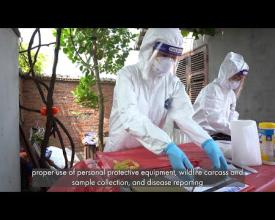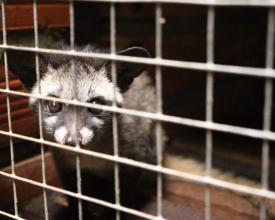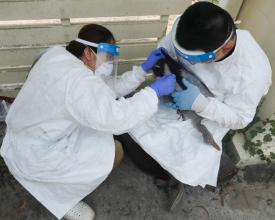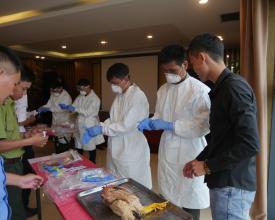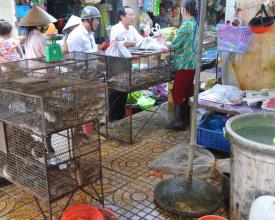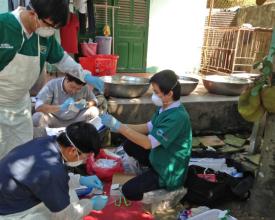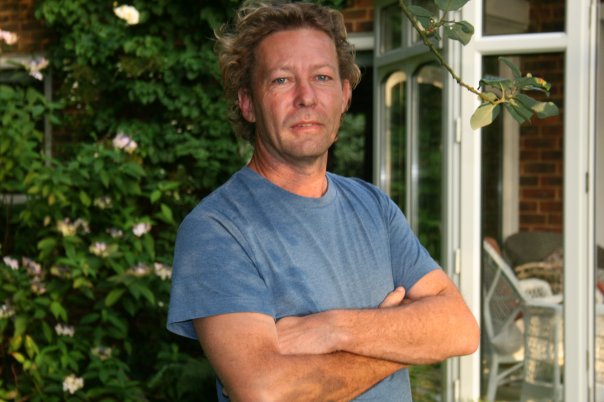
A One Health Approach to Wildlife Trade and Policy in Viet Nam
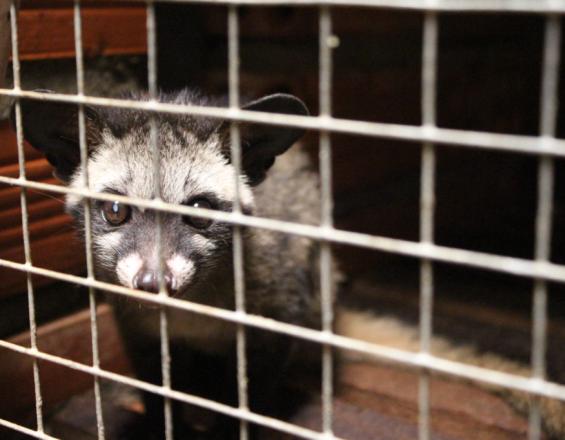
The COVID-19 pandemic, which is widely recognized as originating in a market selling live wildlife in China, has caused the deaths of millions of people and major impacts on livelihoods, society, and economies across the world. Conditions increasing risk for emergence of zoonoses from wildlife are not unique to China. They are prevalent in wild animal value chains across the globe, including in Viet Nam, where wildlife is commonly traded for meat, pets, skins, traditional medicine, and for display in private collections. Disease surveillance along wildlife trade chains in Viet Nam has increased awareness of potential public health risks, but much trade continues and the risk of zoonoses' emergence and transmission remains. An increasing body of scientific data supports multi-sectoral coordination and an evidence-based approach to strengthening policy on illegal wildlife trade (IWT) in Viet Nam to address the risk of zoonotic spillover, with resulting co-benefits for biodiversity and human health.
Context
Challenges addressed
This solution addresses challenges to biodiversity conservation and increased risk of disease spillover posed by conditions along the wildlife trade chain. Wildlife supply chains involve conditions that present a high risk for the emergence, amplification, and transmission of zoonotic pathogens which can lead to outbreaks, epidemics, and pandemics. Live and freshly killed mammals and birds are of particular concern, being main hosts of emerging viral zoonoses, and more prone to shed pathogens when highly stressed. Emergence and amplification risks are greatest in urban and peri-urban markets, where crowding of live wildlife and fresh meat from different species, close to larger numbers of people and other animals, provides ideal conditions for recombination, sharing, and shedding of pathogens and transmission to humans. Few urban consumers depend on wild meat for dietary needs or food security, mainly purchasing or consuming wild meat as a luxury.
Location
Process
Summary of the process
Developing collaborative, cross-sectoral, multidisciplinary, multi-agency One Health frameworks is essential to build effective wildlife surveillance networks as well as to share information and develop trust and understanding of emerging health risks from wildlife in order to implement evidence-based policy change.
Building Blocks
Building long-term, multi-sectoral, trans-disciplinary partnerships and capacities
Building long-term partnerships and capacity for multi-sector surveillance of zoonotic diseases along wildlife trade chains promotes and supports effective One Health collaboration from the spillover frontlines to national and international policy makers, and improved understanding of pathogen diversity, disease dynamics and potential risks posed by wildlife trade. Platforms for regular multi-sector discussion between animal health, environment, enforcement, and human health sectors, as well as with and amongst international and multi-lateral partners, is essential for open discourse and sharing of information on the risks, challenges and opportunities for pandemic prevention. This is critical to improve cross- sectoral trust, understanding, communication and coordination to increase opportunities for effective legislative change and cultural shifts.
Enabling factors
Openness of host governments to coordination between environment, law enforcement, animal health and human health sectors and investment of time and personnel from those sectors in wildlife surveillance for One Health intelligence; patience; funding; One Health coordination platforms
Lesson learned
Trans-sectoral coordination and support from the government is essential from the beginning to ensure effective surveillance for diseases of zoonotic origin along wildlife trade chains and to promote understanding and sharing of findings. Openness of national governments to make science-based policy changes to reduce health risks posed by wildlife trade is essential for meaningful, long-term impact.
Wildlife surveillance for One Health intelligence
Financing support for multi-sector surveillance of zoonotic diseases in wildlife and along wildlife trade chains is essential to improve understanding of pathogen diversity, disease dynamics and potential risks posed by wildlife trade, to support evidence-based decision making, monitor emerging pathogens and support targeted future surveillance and mitigation investments
Enabling factors
Long-term financial support for sustained wildlife surveillance: in the field, in the laboratory and for associated data analysis to inform decision-makers and support reporting through One Health coordination platforms
Lesson learned
It is a challenge to secure funding for longer than the typical short cycles associated with government priorities to really make a difference in capacity and system building. Wildlife and environment sectors typically receive less funding and attention compared with livestock and human health, despite their clear linkages to both and increasing risks of emerging diseases of wildlife origin.
Impacts
Viet Nam banned importation of wildlife in January 2020, in response to COVID-19, and called for heightened enforcement of existing laws on IWT in the Vietnamese Prime Minister’s Directive No. 29 on “urgent solutions to manage wildlife”. In 2020, government representatives, multi-laterals (FAO, WHO, UNEP), NGOs and multiple embassies collaborated through a Pandemic Prevention Task Force and met with the Prime Minister, aiming to reduce risks of pandemic emergence from wildlife trade in Viet Nam by phasing out the commercial trade of wild birds and mammals. Subsequently, a technical working group on “wildlife and pandemics” was established under a three-Ministry One Health partnership platform, the Ministries of Agriculture and Rural Development (MARD), Ministry of Health (MOH) and Ministry of Natural Resources and Environment (MONRE), and a Master Plan for the One Health Partnership Framework for Zoonoses, 2021-2025 was established and signed by WCS, and 30 national and international partners. The Government of Viet Nam has since revised a number of decrees addressing animal health, public health, food safety, and wildlife management with the aim of mitigating the risks and impacts of future pandemics, including Decree 14 (2021) regulating penalties for offenses involving animal husbandry, and Decree 07 (2022) increasing sanctions for violating wildlife trade laws and regulations.
Beneficiaries
Science-based approaches support sound policy choices, benefitting threatened wildlife and the global human population through biodiversity conservation and lowered risk of economic and health crises from spillover of zoonoses.
